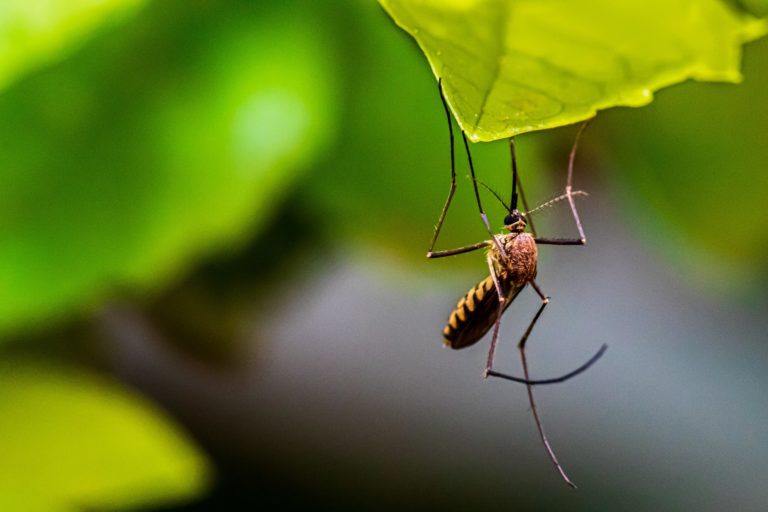While the COVID-19 pandemic has captured the attention of the world’s leading infectious disease experts, the scientific community has continued to track the transmission of mosquito-borne diseases, including West Nile, Zika, Chikungunya, Dengue, and other dangerous illnesses. As of December 14, 2021, the Center for Disease Control (CDC) reports that more than 2,400 human infections of West Nile occurred in the United States in the past year, of which 165 resulted in death. Nearly every state in the country has been affected, with Arizona, Colorado, California, and Nebraska representing the most cases.
Quick Links:
West Nile Virus
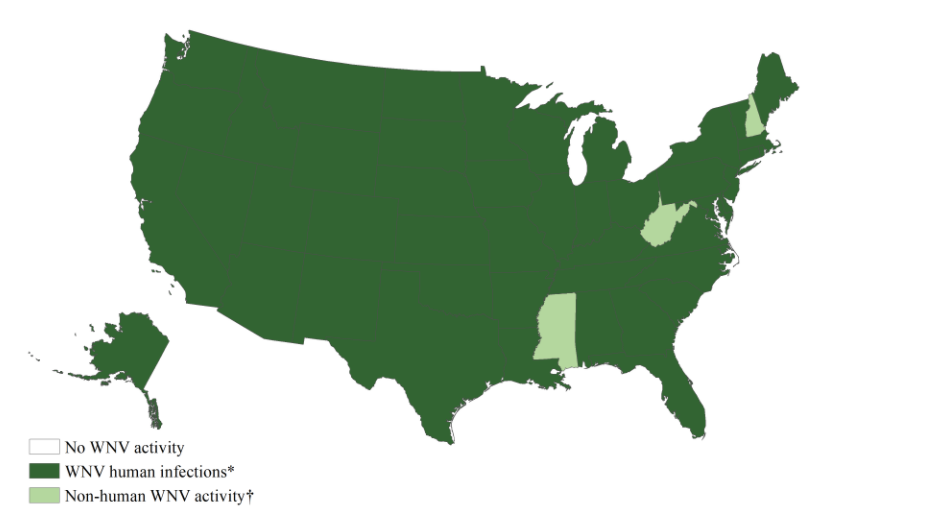 This map from CDC shows West Nile virus activity across the U.S. in 2021.
This map from CDC shows West Nile virus activity across the U.S. in 2021.
As in years past, West Nile virus (WNv) continues to be the most reported and most deadly mosquito-borne disease in the United States. WNv is carried by over 150 species of mosquitoes, which usually pass the virus to humans after feeding on infected birds. Scientists have identified Culex pipiens, Culex tarsalis, and Culex quinquefasciatus as the primary vector species.
Approximately 20% of people infected with WNv experience flu-like symptoms such as nausea, headache, muscle pain, fever, and swollen lymph glands. These symptoms may also be accompanied by rashes, sleepiness, disorientation, and stiff neck. Among those infected, less than 1% will go on to develop West Nile Encephalitis or Meningitis. This can result in tremors, convulsions, paralysis, coma, and even death.
WNv transmission is cyclical in nature, with 2021 data showing a significant increase in both total cases and death:
This chart reflects data taken on December 14, 2021.
2020 – 28 cases in citizens returning from travel, 0 cases in U.S. territories
2019 – 192 cases in citizens returning from travel, 2 cases in U.S. territories
2018 – 116 cases in citizens returning from travel, 8 cases in U.S. territories
To learn more about the symptoms, treatment, and mosquito species that vector this virus, visit our educational page on West Nile virus.
Zika Virus
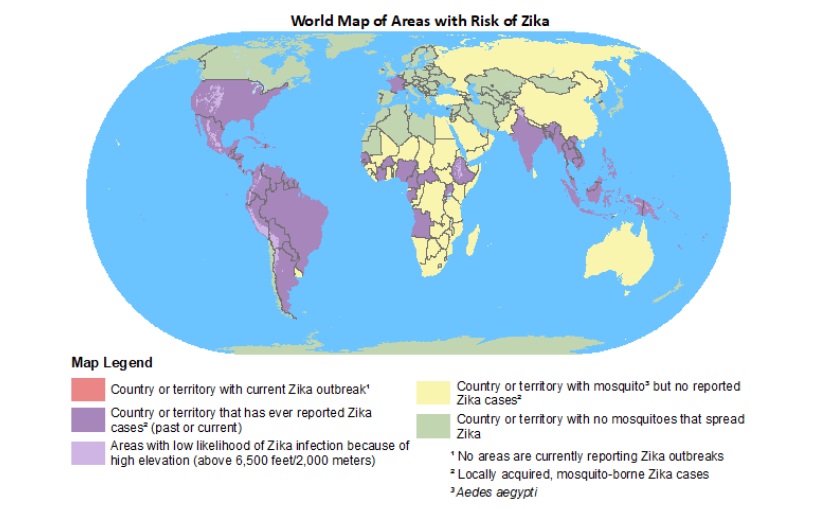 This map from CDC shows Zika virus activity around the world.
This map from CDC shows Zika virus activity around the world.
Zika is a dangerous virus that primarily affects Africa and South America. Historically, U.S. citizens have become infected while traveling abroad, but warming climates have allowed the presence of Zika in the southern United States as well. Unlike other types of viruses, which require an animal reservoir host, mosquitoes are able to transmit Zika by simply feeding on the blood of an infected person. This can increase the spread very quickly during the summer months.
In the United States, Zika is typically transmitted by Aedes aegypti, but growing evidence suggests that the Asian Tiger Mosquito (Aedes albopictus) could also be a vector. Common symptoms of infection include fever, rash, headache, joint pain, muscle pain, and Conjunctivitis (red eyes). Zika very rarely results in death; however, it can cause serious congenital disabilities when an infection occurs during pregnancy. These typically manifest as microcephaly (collapsed skull), decreased brain tissue, eye tissue damage, and joint or muscle tone complications.
After an alarming peak in 2016, when the CDC reported more than 40,000 cases in the U.S. and its territories, Zika cases have decreased to remarkable lows. This may, in part, be due to pandemic-related travel restrictions:
This chart reflects data taken on December 14, 2021.
2020 – 4 cases in citizens returning from travel, 57 cases in U.S. territories
2019 – 27 cases in citizens returning from travel, 74 cases in U.S. territories
2018 – 73 cases in citizens returning from travel, 148 cases in U.S. territories
To learn more about the symptoms, treatment, and mosquito species that vector this virus, visit our educational page on Zika virus.
Chikungunya Virus
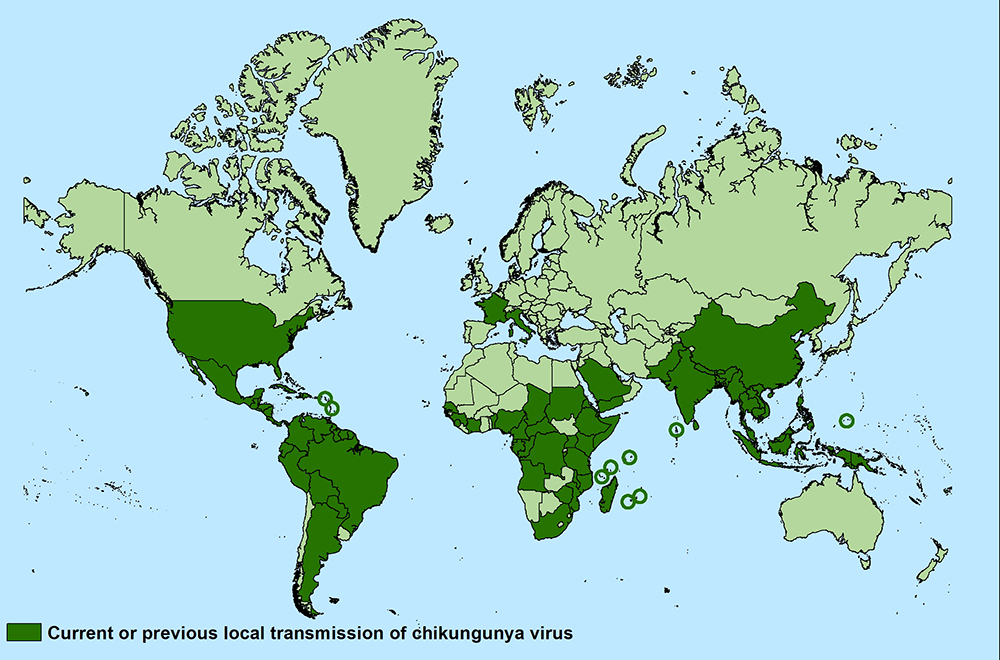 This map from CDC shows Chikungunya virus activity around the world in 2020.
This map from CDC shows Chikungunya virus activity around the world in 2020.
Chikungunya (chik-en-gun-ye) is less well-known than other mosquito-borne diseases, but has become more widespread among American citizens, most often when traveling abroad. Like Zika, Chikungunya virus can spread when mosquitoes feed on a person who is carrying the infection. Chikungunya is also primarily transmitted by Aedes mosquitoes.
Those infected with Chikungunya virus may experience painful and even disabling symptoms that appear 3-7 days after transmission. These most often include fever, severe joint pain, and rash. Death is very rare and, in fact, infected individuals tend to develop immunity from future infections.
Annual U.S. Chikungunya cases have dropped dramatically in recent years - reaching a record low in 2021. This may, in part, be due to pandemic-related travel restrictions and effective mosquito control interventions:
This chart reflects data taken on December 14, 2021.
2020 – 28 cases in citizens returning from travel, 0 cases in U.S. territories
2019 – 192 cases in citizens returning from travel, 2 cases in U.S. territories
2018 – 116 cases in citizens returning from travel, 8 cases in U.S. territories
To learn more about the symptoms, treatment, and mosquito species that vector this virus, visit our educational page on Chikungunya.2018 – 116 cases in citizens returning from travel, 8 cases in U.S. territories.
Dengue Virus
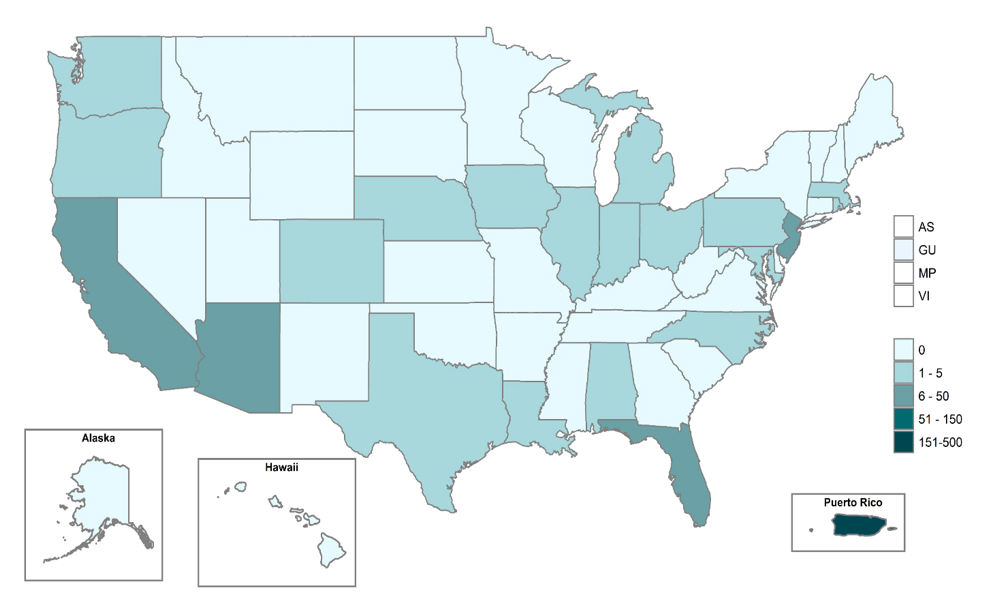 This map from CDC shows Dengue activity across the U.S. in 2021.
This map from CDC shows Dengue activity across the U.S. in 2021.
While many people think of Dengue as a disease we don’t need to worry about in the United States, mosquitoes capable of transmitting this virus are abundant in many areas of the country and quickly expanding their range. Characteristic symptoms of dengue include high fever, rash, in addition to muscle and joint pain. In severe cases there can be serious bleeding or shock, which is life threatening.
In 2021 there were 86 human cases of Dengue diagnosed in 23 states across the continental United States.
To learn more about the symptoms, treatment, and mosquito species that vector this virus, visit our educational page on Dengue.
Monitoring Real-Time U.S. Mosquito-Borne Disease Activity
The key to limiting the spread of mosquito-borne diseases is monitoring and prevention. Municipalities and mosquito abatement districts often execute Integrated Mosquito Management (IMM) programs to help protect communities, but private citizens can support these efforts and empower themselves with disease tracking tools like the CDC’s ArboNet map. The map provides a live overview of reported mosquito activity and the most common vector-borne diseases, including:
- West Nile Virus (WNV)
- St. Louis Encephalitis (SLE)
- Eastern Equine Encephalitis (EEE)
- La Crosse (LAC)
- Dengue (DEN) locally-acquired and travel-associated
- Chikungunya (CHIK) locally-acquired and travel-associated
- Zika Virus (ZIKA) locally-acquired and travel-associated
- Powassan Virus (a tick-borne disease)
*ArboNet is designed to reflect real-time information, but there are times when it may not be in sync. This resource is easy to navigate and can be sorted by disease type, state, and year.
 In addition to staying informed about the risks posed by mosquitoes in your community, it’s important to observe any travel warnings issued by the CDC, particularly when pregnant. It’s also essential to exercise personal protection measures like wearing insect repellent and exercising best practices around your property to reduce mosquito reproduction.
In addition to staying informed about the risks posed by mosquitoes in your community, it’s important to observe any travel warnings issued by the CDC, particularly when pregnant. It’s also essential to exercise personal protection measures like wearing insect repellent and exercising best practices around your property to reduce mosquito reproduction.
VDCI is committed to public education and spreading awareness throughout the U.S. about the dangers of mosquito-borne diseases and their preventability, with the overarching goal of reducing illness and fatalities. Our dedicated and experienced team works tirelessly with local governments to prevent the spread of mosquito-borne diseases in all of the contracts we service from coast to coast.
VDCI Wants To Make Your Community Safer. How Can We Help?
Speak to an expert about implementing an IMM program.
Fill out the information below, and one of our experts will follow up with you shortly.
Since 1992, Vector Disease Control International (VDCI) has taken pride in providing municipalities, mosquito abatement districts, industrial sites, planned communities, homeowners associations, and golf courses with the tools they need to run effective mosquito control programs. We are determined to protect the public health of the communities in which we operate. Our mosquito control professionals have over 100 years of combined experience in the field of public health, specifically vector disease control. We strive to provide the most effective and scientifically sound mosquito surveillance and control programs possible based on an Integrated Mosquito Management approach recommended by the American Mosquito Control Association (AMCA) and Centers for Disease Control and Prevention (CDC). VDCI is the only company in the country that can manage all aspects of an integrated mosquito management program, from surveillance to disease testing to aerial application in emergency situations.


